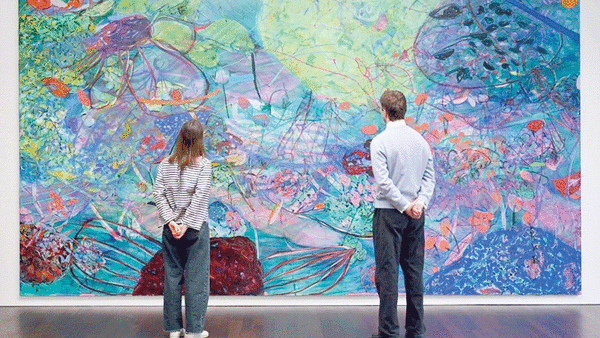

London’s Gagosian gallery is hosting a major new exhibition of abstract art, bringing together the playful use of textures by young artists and traditional work of veterans in the field.
“Abstract painting is a term that we’ve been trying to define for over 100 years and there is no consensus,” curator Gary Garrels told AFP on Thursday at the opening of the show, which runs until August 25.
“For me, abstract painting is painting that is having an internal conversation where the issues of the painting itself — colour, surface, texture, materials, scale — are the primary parts of the conversation that’s not referring to something outside the painting, that’s somehow descriptive.”
Garrels spent 18 months visiting the studios of “three generations” of artists to bring together 41 recent paintings for the exhibition — “To Bend the Ear of the Outer World”
Some are from well-known artists, others are by virtual unknowns.
The overall aim is to take the pulse of a movement that has sometimes been seen as a dying art form.
But Garrels insisted: “It’s far from being dead. It’s very much alive. We have another good century ahead of us. Incredible range, richness and diversity.”
To demonstrate that abstract art is very much alive, the show opens with contrasting paintings by two European artists of the same age.
One — “It’s not yesterday anymore” (2022) — is by British painter Cecily Brown’s explosion of harsh brushstrokes and colours.
The other — “Emko” (2023) — by Germany’s Tomma Abts, is small, precise, monochromatic and geometrical. Each painting is displayed on its own, on a large white wall, to highlight each artist’s individuality.

No movement
The rooms of the Gagosian gallery are organised according to links between the painters, whether temporal, geographical or stylistic.
Veteran German painter Gerhard Richter’s richly variegated “Abstraktes Bild” (2017) is coupled with the minimalist “Rivers (2020-21) by American artist Brice Marden and the organic fluidity of Pat Steir’s “Rainbow Waterfall #6”.
“They began their serious, mature work and were recognised in the 1960s but have continued to make great painting,” said Garrels.
At the other end of the scale, Columbia’s Oscar Murillo’s “Manifestation” (2020-22) combines conventional oil paint with oil stick, graphite and spray paint on canvas and linen.
Its dramatic thick dark strokes contrast with the lightness and luminosity of “Untitled” (2022) by the young American Ryan Sullivan.
With Sullivan’s use of moulded cast urethane resin, fibreglass and epoxy, both have free reign in their use of textures.
Garrels says “there’s no movement” in abstract painting.
“It’s not like we have abstract expressionism or colour field painting. We have individual artists pursuing their own visions,” he added.
For some, the medium is all about the expressiveness of the stroke, while others focus on “quiet” art based on pure, almost homogeneous surfaces, with few tonal nuances.
Many of these artists have friendships that, according to Garrels, are reflected in the dialogue between their works.
American artist Jacqueline Humphries and US-based German artist Charline von Heyl for example share a taste for indirect painting, mediated by screens or other tools.
That gives their work an elusive character that is difficult to take in.
The exhibition mainly features German, American and British artists.
Murillo, who was born in the city of La Paila, has dual Colombian-British nationality. He emigrated to the UK with his family, and trained and now lives in London. — AFP
Oman Observer is now on the WhatsApp channel. Click here


